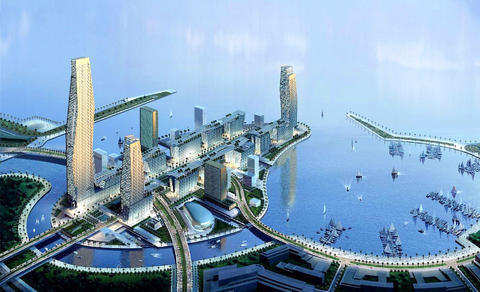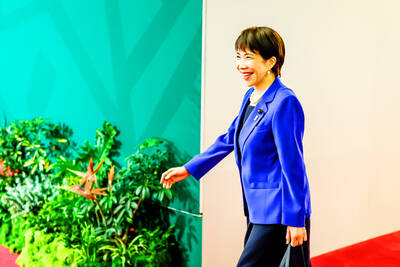The alarm bell sounded the end of the lunch break here one November afternoon and suddenly thousands of workers -- on foot, on bicycles and in buses -- streamed in, seemingly from out of nowhere, and jolted this huge construction site to life.
Amid a forest of cranes, towers and beams rising from the desert, more than 38,000 workers from China, India, Turkey and beyond have been toiling for two years in unforgiving conditions -- often in temperatures exceeding 37oC -- to complete one of the world's largest petrochemical plants in record time.
By the end of the year, this massive city of steel at the edge of the Red Sea will take its place as a cog of globalization: Plastics produced here will be used to make televisions in Japan, mobile phones in China and thousands of other products to be sold in the US and Europe. Construction costs at the plant, which spreads over 20km2, have doubled to US$10 billion because of shortages in materials and labor. The amount of steel being used is 10 times the weight of the Eiffel Tower.

PHOTO: NY TIMES NEWS SERVICE
"I've worked on many big things in my life, but I've never worked on anything this big," an American project manager mused during a bus tour of the project, called Petro Rabigh, a joint venture of the state-run oil company Saudi Aramco and Sumitomo Chemical of Japan.
Size is not the only consideration. The project is Saudi Arabia's boldest bet yet that this oil-rich kingdom can transform itself into an industrial powerhouse. The plant is part of a US$500 billion investment program to build new cities, create millions of jobs and diversify the economy away from petroleum exports over the next two decades.
"The Saudi economy was in idle mode for 20 years," said John Sfakianakis, the chief economist at SABB, formerly known as the Saudi British Bank, who is based in Riyadh, the Saudi capital. "Today, the feeling here is, `We've won the lottery; let's not waste it.'"
The kingdom's lofty economic goals would have been unthinkable without the surge in energy prices that has filled the coffers of oil producers. Oil prices have quadrupled since 2002 and reached US$100 a barrel in New York this month.
Persian Gulf countries earned US$1.5 trillion in oil revenue from 2002 to 2006, twice as much as in the previous five-year period, data from the Institute of International Finance, a global association of banks based in Washington, showed. As the top exporter, Saudi Arabia has been the main beneficiary.
Despite all the recent headlines about Middle East investors bailing out troubled US banks like Citigroup, a growing share of today's petrodollars are staying at home to finance mega-projects like Petro Rabigh, analysts say. That money is financing the biggest economic boom in a generation, helping to build not only the high-rises of Dubai, where the world's tallest tower is going up, but also telecommunications networks, roads and universities throughout the Middle East.
Abu Dhabi is planning to spend close to US$1 billion for a new museum with the help of the Louvre, in Paris. Dubai's latest grandiose idea is to build a small-scale replica of the French city of Lyon, complete with housing, a museum, a culinary school and a soccer club.
In Saudi Arabia, Riyadh looks like a boomtown: Sprawling over 64km, it is teeming with shopping malls, electronics retailers and luxury boutiques. But while times are good today, many Saudis realize that their country is locked in a race against time to create industries that produce more than just oil in order to keep a young and growing population employed. The kingdom, which has a population of 24.5 million, including nearly 7 million foreigners, has what one analyst called a "human time bomb." About 40 percent of Saudis are under 15, and because the country has one of the world's highest birthrates, the population is expected to reach nearly 40 million by 2025.
"It has been a social, and therefore a political, imperative of the Saudi government to develop the economy and to create employment opportunities," said Timothy Gray, the chief executive of HSBC Saudi Arabia.
That could well mean that higher oil prices are here to stay. One paradox of modern-day Saudi Arabia is that while it seeks to reduce the importance of petroleum to its economy, it needs those exports more than ever.
To be sure, the region's economies are too small to absorb all the oil riches on their own. Too much money is chasing too few assets, analysts say, forcing oil producers to invest some of their revenue abroad and diversify their holdings, either through opaque state-owned investment funds or through direct private investments.
Last year, for example, a fund controlled by the government of Abu Dhabi bought a stake in Citigroup for US$7.5 billion, while another run by Dubai's ruler bought a large share in Sony, the Japanese consumer electronics giant. Sabic, a major Saudi petrochemical company, bought the plastics division of General Electric for US$11.6 billion and the Kuwait Petroleum Corp bought half of Dow Chemical's commodity plastics unit for US$9.5 billion.
In recent weeks, other big banks plagued by losses from the mortgage crisis, like Merrill Lynch and Morgan Stanley, have raised tens of billions of dollars from a variety of Middle Eastern and Asian funds, including ones from Kuwait or Saudi Arabia.
Data compiled by Bloomberg News shows that overseas investments by Persian Gulf countries reached a record US$75 billion last year. Arms deals, a timeworn way of recycling petrodollars, remain popular in the region; the US is pushing for a US$20 billion weapons sale to Saudi Arabia, for example. But while oil-rich states are still buying US Treasury bonds or military hardware from the West, analysts say the more significant trend is for a growing share of their investments to be pumped into local projects.
"The vision is to turn the kingdom into a major industrial power by 2020," said Georgetown University's Jean-Francois Seznec, who is a specialist in industrial policies in the Persian Gulf. "A billion dollars here and a billion there and soon you're talking about real money."
Projects like Petro Rabigh, Seznec said, will allow Saudi Arabia to become one of the top three chemical producers in the world within a few years. Unlike Kuwait or Abu Dhabi, Saudi Arabia does not have a sovereign fund responsible for investing the country's petroleum riches.
Ali al-Naimi, the kingdom's energy minister and one of the grand architects of Saudi industrial policy, summed up the nation's goals at a dedication ceremony for Petro Rabigh in 2006.
"I would like to highlight the fact that the Petro Rabigh project is part of a bigger picture," Naimi said at the time. "This strategy includes expanding the base of the Saudi economy, diversifying national income sources, attracting international investments and reaping the direct and indirect benefits that these types of projects will accrue to the Saudi citizen."
One of the most noticeable illustrations of the industrialization push is a plan championed by King Abdullah, the 83-year-old Saudi monarch, to build six new cities throughout the country -- including the King Abdullah Economic City on the western coast; the Knowledge Economic City, near Medina; and the Prince Abdulaziz bin Mousaed Economic City, in the north.
The intent is to create industrial centers that double as housing and commercial hubs for the country's young and growing population. The Saudi Arabian General Investment Authority, a government agency, expects these cities to add US$150 billion to the country's GDP by 2020, create 1 million new jobs and be home to as many as 5 million people.
Drawings of these new towns depict a cross of the futuristic Blade Runner and traditional Arabic design. But the new cities are also expected to become new industrial centers.
SABB says these cities together will have four times the geographical area of Hong Kong, three times the population of Dubai and an economic output equal to Singapore's. Other plans include building four refineries, two petrochemical plants and a modern graduate-level university.
The frenzied growth of the economy has had some serious downsides. Inflation has been rampant; food prices and rents have risen sharply. Traffic jams in Riyadh and other cities have become a constant affliction, while real estate values have soared and the construction sector is strained by a lack of workers.

LIMITS: While China increases military pressure on Taiwan and expands its use of cognitive warfare, it is unwilling to target tech supply chains, the report said US and Taiwan military officials have warned that the Chinese People’s Liberation Army (PLA) could implement a blockade within “a matter of hours” and need only “minimal conversion time” prior to an attack on Taiwan, a report released on Tuesday by the US Senate’s China Economic and Security Review Commission said. “While there is no indication that China is planning an imminent attack, the United States and its allies and partners can no longer assume that a Taiwan contingency is a distant possibility for which they would have ample time to prepare,” it said. The commission made the comments in its annual

DETERMINATION: Beijing’s actions toward Tokyo have drawn international attention, but would likely bolster regional coordination and defense networks, the report said Japanese Prime Minister Sanae Takaichi’s administration is likely to prioritize security reforms and deterrence in the face of recent “hybrid” threats from China, the National Security Bureau (NSB) said. The bureau made the assessment in a written report to the Legislative Yuan ahead of an oral report and questions-and-answers session at the legislature’s Foreign Affairs and National Defense Committee tomorrow. The key points of Japan’s security reforms would be to reinforce security cooperation with the US, including enhancing defense deployment in the first island chain, pushing forward the integrated command and operations of the Japan Self-Defense Forces and US Forces Japan, as

IN THE NATIONAL INTEREST: Deputy Minister of Foreign Affairs Francois Wu said the strengthening of military facilities would help to maintain security in the Taiwan Strait Japanese Minister of Defense Shinjiro Koizumi, visiting a military base close to Taiwan, said plans to deploy missiles to the post would move forward as tensions smolder between Tokyo and Beijing. “The deployment can help lower the chance of an armed attack on our country,” Koizumi told reporters on Sunday as he wrapped up his first trip to the base on the southern Japanese island of Yonaguni. “The view that it will heighten regional tensions is not accurate.” Former Japanese minister of defense Gen Nakatani in January said that Tokyo wanted to base Type 03 Chu-SAM missiles on Yonaguni, but little progress

NO CHANGES: A Japanese spokesperson said that Tokyo remains consistent and open for dialogue, while Beijing has canceled diplomatic engagements A Japanese official blasted China’s claims that Japanese Prime Minister Sanae Takaichi has altered Japan’s position on a Taiwan crisis as “entirely baseless,” calling for more dialogue to stop ties between Asia’s top economies from spiraling. China vowed to take resolute self-defense against Japan if it “dared to intervene militarily in the Taiwan Strait” in a letter delivered Friday to the UN. “I’m aware of this letter,” said Maki Kobayashi, a senior Japanese government spokeswoman. “The claim our country has altered its position is entirely baseless,” she said on the sidelines of the G20 summit in Johannesburg on Saturday. The Chinese Ministry